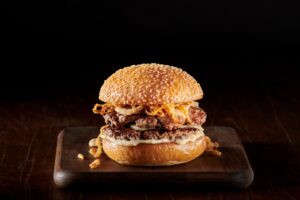Learn key ways to add extra benefits to foods that people with dementia already enjoy.
Getting memory-care community residents to eat is a hard job. Getting memory-care residents the nutrition they need is even tougher. People living with dementia face many obstacles when it comes to food, things such as vision problems that make food less appetizing, sensory overload when sitting in a crowded, noisy dining room, or simply just skipping meals by thinking they’ve already eaten. When any of these obstacles interfere, fortified foods can provide higher nutrient density with smaller amounts of food.
There’s nothing special about fortified foods. They can be common real-food choices that your residents or patients already enjoy. The goal, says Gordon Food Service Nutrition Resource Centre Dietitian Jessie Waalkes, is to take those foods and add extra calories and protein to prevent malnutrition that can increase the risk of health issues.
“Fortified foods are generally traditional foods with extras added in sneaky ways,” Waalkes says. “It can be as simple as adding more butter and sour cream to mashed potatoes or serving oatmeal or cream of wheat made with whole milk instead of skim.”
A focus on food first
Fortified foods aren’t just for people living with memory-care issues. They can work with any resident or patient. For people recovering from an illness, fortified foods are a solution to providing the calories or nutrients they’ve been missing.
“We always want people eating real food first before ordering a supplement,” Waalkes says. “And the food can be delicious and satisfying.”
In healthcare settings, where meals are prepared in bulk, she suggests serving the people on fortified diet orders a “super gravy” filled with extra calories on turkey and mashed potato night. If one resident insists on a peanut butter and jelly sandwich instead, that can work too. Butter the bread before placing on the peanut butter—it won’t change the flavour but will add the extra calories.
Recognize the need
You can often tell when someone’s not eating much, Waalkes says. You may observe food left on the plate or notice weight loss, and both are signs that fortified foods could be necessary. But the reason for poor eating should get attention as well. There are five factors that lead to impaired food intake for people in memory care settings:
- Cognitive difficulties. The patient doesn’t recognize food or drink as something intended for consumption.
- Motor difficulties. The patient is unable to use utensils or chew foods properly.
- Sensory difficulties. The patient has a diminished sense of smell or taste, cannot regulate thirst, has a hard time detecting food temperatures or cannot distinguish food items on a plate.
- Eating behaviours. The resident is agitated, changes his eating habits, refuses to eat or overeats, changes food preferences or plays with food.
- Poor appetite. The resident’s medication or lack of exercise affect the desire to eat.
These factors are important to recognize, because addressing them may be as much a part of the solution as fortified foods. A fortified food such as nuts may be very nutritious, for example, but if the resident has trouble chewing, the nuts won’t be eaten. Nut butter may be a better choice. The same goes for chicken, mashed potatoes and cottage cheese—all are very nutritious, but may be hard to distinguish visually when served on a white plate. Using dark-coloured plates so foods stand out more may help people who cannot distinguish food items on the plate.
Finding the right strategy
While most people savour mealtime, those with memory issues cannot. They lack focus to sit and talk for an hour. With a small mealtime window, fortified foods can provide a quick high-protein, nutritionally dense and calorie-packed way to eat. Use these suggestions to turn ordinary food into fortified food:
Dairy products. In recipes that use milk, choose whole milk. Be sure to check for lactose intolerance. Also look for ways to use pudding, yogurt, cottage cheese, ice cream. Eggs are also an excellent protein source.
Cereals. Fortify hot cereals with powdered milk, butter or mix in syrup.
Mashed foods. Add butter or protein to potatoes, sweet potatoes, turnips, carrots that can be cooked and mashed to create soft foods for those who have trouble chewing.
Soups. Add more vegetables or chicken to a chicken noodle soup. Instead of a broth base, make a creamy bisque using real butter and cream.
Gravies and sauces. Add powdered milk, use a fat-based stock or infuse them with cream.
Casseroles. Add cheese, whole milk, gravy or bite-sized pieces of meat.
Desserts. Cookies, candy bars, smoothies and milk shakes are sweet, portable and calorie-packed.
Handhelds. Hard-boiled eggs, meatball sliders, chicken fingers, empanadas and other handhelds.
Solutions abound
There are many ways to deliver fortified foods. The answer can be as simple as substituting whipping cream for half-and-half in a cup of coffee or adding an extra slice of cheese to a grilled cheese sandwich. Waalkes recalls a resident at a community where she once worked who craved peanut butter cups. While peanut butter cups are not a solution she recommends for everyone, there was a lesson to be learned.
“It’s all she wanted to eat. They have a little bit of protein and a little bit of peanut butter and a whole lot of calories, so that’s what we encouraged her to eat when she wasn’t eating anything else. You have to meet them where they’re at.”

























